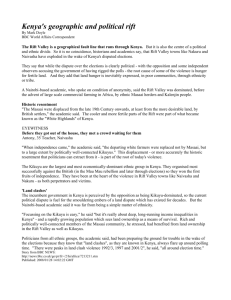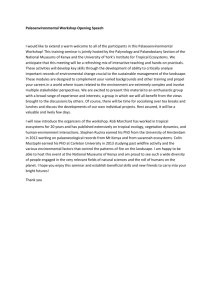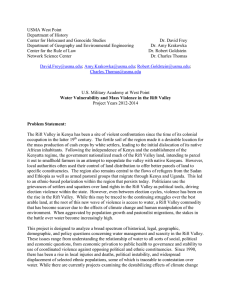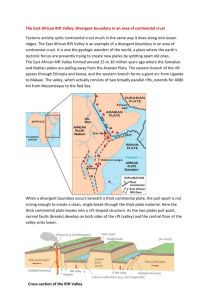Document 11492847
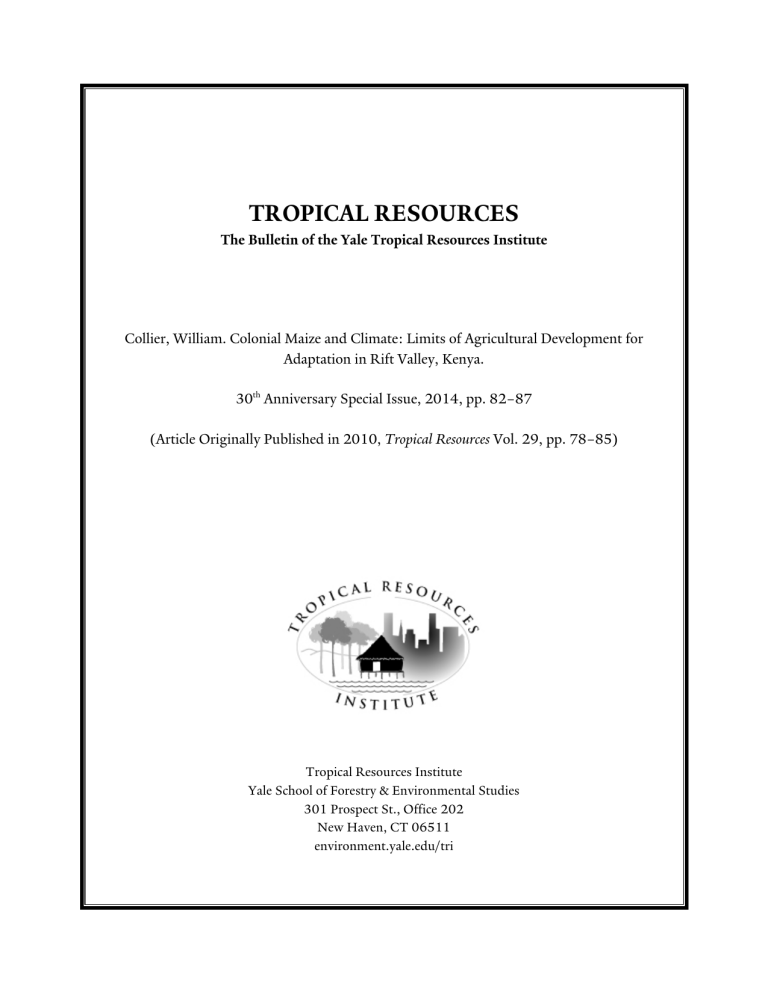
TROPICAL RESOURCES
The Bulletin of the Yale Tropical Resources Institute
Collier, William. Colonial Maize and Climate: Limits of Agricultural Development for
Adaptation in Rift Valley, Kenya.
30 th Anniversary Special Issue, 2014, pp. 82–87
(Article Originally Published in 2010, Tropical Resources Vol. 29, pp. 78–85)
Tropical Resources Institute
Yale School of Forestry & Environmental Studies
301 Prospect St., Office 202
New Haven, CT 06511 environment.yale.edu/tri
Article Originally Published in 2010, Tropical Resources Vol. 29, pp. 10–15
Colonial Maize and Climate:
Limits of Agricultural Development for
Adaptation in Rift Valley, Kenya
William Collier, MESc 2010
Introduction
for future development and climate adaptation.
systems in Sub-Saharan Africa. Increased variability Local populations in the Rift Valley have adapted to variable climatic conditions over hundreds variability and temperature in the Rift Valley will climate for hundreds, if not thousands, of years. and they may provide an avenue to adapt to future by national policies and research objectives.
they are also deeply historical and political.
In this article, I examine the recent history
I discuss several historical adaptations to climate variability embedded within the broader political coincide with local cultures and environmental
William M. Collier is from Free Home, GA. He holds a BS in Ecology and a Certi fi cate in Environmental Ethics from the University of Georgia. He received a MESc in Social
Ecology from the Yale School of Forestry and Environmental Studies, focusing on agricultural development, climate change, and food security in Sub-Saharan Africa.
Thirtieth Anniversary Special Issue Tropical Resources Bulletin 82
William Collier (2010)
Figure 1.
Political map of Kenya. Fieldwork was conducted in
Moiben Division,
Rift Valley Province, located northeast of
Eldoret. Map courtesy of Nations Online
Project.
in the Western Province and the Rift Valley Province,
Pre-colonial agrarian history commonly known as the breadbasket of the country,
Rift Valley have provided fertile soils and favorable climatic conditions to farmers for thousands of years. tremendous varieties of millets and tubers, a stark contrast to their famous nomadic contemporaries, the
Interviews with small, medium, and employees form the basis of the study. Interview cultivation practices is sparse, it is clear that trade in foodstuffs between different tribes in the
Rift Valley was a common practice, especially development in the Rift Valley.
Thirtieth Anniversary Special Issue Tropical Resources Bulletin 83
William Collier (2010)
Colonial rule and New World crops
Western exploration and expansion in and economic development. Perhaps one of the establishment and proliferation of Western cereals
Zea mays became substitutes for the traditional varieties of mercantilism and formal colonialism in the sixteenth a staple of the local diet, and by the mid-nineteenth
Policies for monoculture cash crops policy, have played a fundamental role in contemporary
In the early part of the twentieth century, cheap food source, as the main form of sustenance
Figure 2 . Desiccated maize fi eld, Moiben
Division, Rift Valley,
Kenya. A fi eld of maize intercropped with beans is withering due to insu ffi cient rains. Photo by William Collier.
Thirtieth Anniversary Special Issue Tropical Resources Bulletin 84
William Collier (2010) correct policy would be to return at the earliest possible moment to a reduced production of cereals and an was unwise. But now, after more than four decades
Future Climate Adaptation
Homegardens and climate variability that the only practical option was to develop a
Figure 3.
Agricultureforest mosaic in
Moiben Division, Rift
Valley, Kenya. The agricultural landscape is dominated by large tracts of maize and wheat. A relic of a colonial plantation is located in the center of the valley. Photo by
William Collier.
Thirtieth Anniversary Special Issue Tropical Resources Bulletin 85
William Collier (2010)
Figure 4.
Home garden in Moiben
Division, Rift Valley,
Kenya. This small home garden -- containing pumpkin, kales, cassava, maize, and bananas
-- provides a diverse source of subsistence for smallholder farmers during drought and climate variability. Photo by
William Collier.
also provide a window into the broader history of environmental conditions, these crops exhibit a variety for farmers to rely on and develop their own resources despite the transformations of the colonial experience
(Dove 1990).
Implications for adaptation
When weather conditions are unfavorable, anticipated to exacerbate food insecurity, there will economic, environmental, social, and political
Thirtieth Anniversary Special Issue scientists and policy planners have heralded the
Tropical Resources Bulletin 86
William Collier (2010) adoption as its most visible expression, are already adaptation initiatives that focus exclusively on new productivity will not solve current and future food crises. They may very well continue to perpetuate a system that increases the vulnerability of poor smallholder farmers.
food supplies have been manipulated to consoli-
beyond unwise and vulnerable policies and investtinued dependencies. Yet these are merely whis-
to improve with the anticipated impacts of climate the historical, political, and economic circumstances
Acknowledgement support of the Yale Tropical Resources Institute, the
Thirtieth Anniversary Special Issue Tropical Resources Bulletin 87

